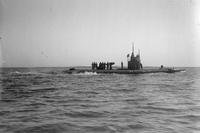Russian television tells us that Vladimir Putin would rather go nuclear than accept defeat in Ukraine. President Biden has admonished that “idle comments about the use of nuclear weapons” are “irresponsible.” Opinion polls on both sides show widespread concern about a nuclear exchange. But Putin only talks about nuclear war because he has nothing else to say.
The war in Ukraine has not gone the way Kremlin decision-makers expected. The Ukrainian people have resisted more determinedly than Moscow (or Washington) predicted, and the international community has responded aggressively in a way the Kremlin did not anticipate. This is not like the 2008 invasion of Georgia, which passed with no effective response from the West, or 2014 when Russia seized and illegally annexed Crimea. Moscow effectively got away with those acts of aggression. However, the current war, exceedingly brutal, unprovoked, and unnecessary, has prompted a determined response.
Operations in Ukraine have unmasked Russian conventional power as a paper tiger. While it was widely expected before the invasion that Ukrainian troops would quickly be overwhelmed, Putin’s forces proved to be inexperienced, unmotivated, ineptly led, and poorly supplied. Columns moving on Kyiv ground to a halt and withdrew; forces in the south and east have better managed to seize ground, but whether they can hold it is another matter.
Ukraine’s forces have benefitted from ample supplies from Western countries, which have helped them to blunt Russia’s attacks. The United States and NATO have ruled out direct military intervention, but imagine if there was a force-on-force conventional engagement. Russia’s air forces would quickly cease to exist. The Russian Baltic Fleet would join the Moskva on the sea floor. Russian ground forces would face the full weight of more motivated, better trained, equipped, and supplied NATO forces. It would be a rout.
To get an idea of how this confrontation might unfold, recall the February 7, 2018 firefight in Syria between U.S. special operations forces and hundreds of Russian “mercenaries,” along with some Syrian government troops. The Americans were outnumbered more than ten to one, but a combination of precision airstrikes, lethal indirect fire and determined assault tactics drove the attacking force off with heavy losses. There were no American casualties.
If the Russian Army ever had any deterrence value, the war in Ukraine put an end to it. So, the only thing Moscow has left is its nuclear arsenal. Russia has around 6,000 nuclear warheads, of which about a quarter are deployed and ready to use. True, this force is a fraction the size of the Soviet Union’s nuclear stockpile at its peak, but as the bumper-sticker from those days said, even one nuclear weapon can ruin your whole day.
Bear in mind we have heard this all before. The Kremlin has never been shy about making nuclear threats. In 2008, during the Georgia crisis, Russia threatened Poland with a nuclear response to deploying a U.S. missile defense system. In 2014, Russian Foreign Minister Sergey Lavrov made veiled reference to a nuclear attack over the Crimea issue. And in March 2018, Putin himself unveiled “invincible” new nuclear weapons with a video suggesting an attack on Florida, for some reason.
Of course, threatening to use nuclear weapons and actually using them are two different things. Putin promised “consequences you have never seen” for intervening in Ukraine, but consequences go both ways. The old parameters of nuclear war have not changed. The United States is also a nuclear power, with a force at least as lethal and survivable as Russia’s, and any strategic nuclear attack on the U.S. or its allies would mean an immediate, devastating counterattack. Destruction is still mutually assured.
Putin knows this. He may pretend to be unhinged when it is convenient, but he is not suicidal. Neither is Joe Biden, which is why NATO forces will not intervene directly and push the conflict into the red zone. The alternative would be a war of mutual annihilation between the two old rivals, with China left to pick up the radioactive pieces.
Dr. Robbins is a former special assistant in the Office of the Secretary of Defense, and in 2007 was awarded the Chairman of the Joint Chiefs of Staff Joint Meritorious Civilian Service Award.
This article originally appeared on 19fortyfive.com.















